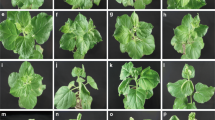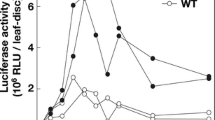Abstract
Tomato aspermy virus (TAV) and cucumber mosaic virus (CMV) belong to the genus Cucumovirus in the family Bromoviridae. The cucumovirus 2b protein is one of the first identified viral suppressors of RNA silencing (VSR). The cucumovirus 2b protein contains a conserved amino acid motif consisting of several highly conserved amino acid residues. Here, we demonstrate that the TAV 2b protein N-terminal region, Arg46, Ser40, and Ser42 as well as the CMV 2b protein are essential for VSR activity, virulence, and viral RNA accumulation. Furthermore, we developed the first TAV-induced gene silencing (VIGS) vector. In contrast to other cucumovirus vectors, such as CMV and peanut stunt virus, the TAV vector did not induce a silencing phenotype in Nicotiana benthamiana when 2b protein VSR activity was retained. These findings suggest that the cucumovirus 2b proteins share amino acid residues for VSR activity but may have different roles in VIGS induction.




Similar content being viewed by others
References
Palukaitis P, García-Arenal F (2003) Cucumoviruses. Adv Virus Res 62:241–323. https://doi.org/10.1016/S0065-3527(03)62005-1
Hayes RJ, Buck KW (1990) Complete replication of a eukaryotic virus RNA in vitro by a purified RNA-dependent RNA polymerase. Cell 63:363–368. https://doi.org/10.1016/0092-8674(90)90169-F
Ding S-W, Li W-X, Symons RH (1995) A novel naturally occurring hybrid gene encoded by a plant RNA virus facilitates long distance virus movement. EMBO J 14:5762–5772. https://doi.org/10.1002/j.1460-2075.1995.tb00265.x
Schwinghamer MW, Symons RH (1975) Fractionation of cucumber mosaic virus RNA and its translation in a wheat embryo cell-free system. Virology 63:252–262. https://doi.org/10.1016/0042-6822(75)90389-X
Shi B, Ding S, Symons RH (1997) Two novel subgenomic RNAs derived from RNA 3 of tomato aspermy cucumovirus. J Gen Virol 78:505–510. https://doi.org/10.1099/0022-1317-78-3-505
Baulcombe D (2004) RNA silencing in plants. Nature 431:356–363. https://doi.org/10.1038/nature02874
Csorba T, Kontra L, Burgyán J (2015) viral silencing suppressors: tools forged to fine-tune host-pathogen coexistence. Virology 479–480:85–103. https://doi.org/10.1016/j.virol.2015.02.028
Guo HS, Ding SW (2002) A viral protein inhibits the long range signaling activity of the gene silencing signal. EMBO J 21:398–407. https://doi.org/10.1093/emboj/21.3.398
Goto K, Kobori T, Kosaka Y et al (2007) Characterization of silencing suppressor 2b of cucumber mosaic virus based on examination of its small RNA-binding abilities. Plant Cell Physiol 48:1050–1060. https://doi.org/10.1093/pcp/pcm074
Zhang X, Yuan Y-R, Pei Y et al (2006) Cucumber mosaic virus-encoded 2b suppressor inhibits Arabidopsis Argonaute1 cleavage activity to counter plant defense. Genes Dev 20:3255–3268. https://doi.org/10.1101/gad.1495506
Duan C-G, Fang Y-Y, Zhou B-J et al (2012) Suppression of Arabidopsis ARGONAUTE1-mediated slicing, transgene-induced RNA silencing, and DNA methylation by distinct domains of the cucumber mosaic virus 2b Protein. Plant Cell 24:259–274. https://doi.org/10.1105/tpc.111.092718
Cao X, Zhou P, Zhang X et al (2005) Identification of an RNA silencing suppressor from a plant double-stranded RNA virus. JVI 79:13018–13027. https://doi.org/10.1128/JVI.79.20.13018-13027.2005
Chen H-Y, Yang J, Lin C, Yuan YA (2008) Structural basis for RNA-silencing suppression by tomato aspermy virus protein 2b. EMBO Rep 9:754–760. https://doi.org/10.1038/embor.2008.118
Zhang X, Du P, Lu L et al (2008) Contrasting effects of HC-Pro and 2b viral suppressors from sugarcane mosaic virus and tomato aspermy cucumovirus on the accumulation of siRNAs. Virology 374:351–360. https://doi.org/10.1016/j.virol.2007.12.045
Ding S-W, Anderson BJ, Haase HR, Symons RH (1994) New overlapping gene encoded by the cucumber mosaic virus genome. Virology 198:593–601. https://doi.org/10.1006/viro.1994.1071
Kobori T, Ryang B-S, Natsuaki T, Kosaka Y (2005) A new technique to select mild strains of cucumber mosaic virus. Plant Dis 89:879–882. https://doi.org/10.1094/PD-89-0879
Mochizuki T, Yamazaki R, Wada T, Ohki ST (2014) Coat protein mutations in an attenuated cucumber mosaic virus encoding mutant 2b protein that lacks RNA silencing suppressor activity induces chlorosis with photosynthesis gene repression and chloroplast abnormalities in infected tobacco plants. Virology 456–457:292–299. https://doi.org/10.1016/j.virol.2014.04.010
Nemes K, Gellért Á, Almási A et al (2017) Phosphorylation regulates the subcellular localization of cucumber mosaic virus 2b protein. Sci Rep 7:13444. https://doi.org/10.1038/s41598-017-13870-7
Nemes K, Gellért Á, Balázs E, Salánki K (2014) Alanine scanning of cucumber mosaic virus (CMV) 2B protein identifies different positions for cell-to-cell movement and gene silencing suppressor activity. PLoS ONE 9:e112095. https://doi.org/10.1371/journal.pone.0112095
Burch-Smith TM, Anderson JC, Martin GB, Dinesh-Kumar SP (2004) Applications and advantages of virus-induced gene silencing for gene function studies in plants. Plant J 39:734–746. https://doi.org/10.1111/j.1365-313X.2004.02158.x
Hong JS, Rhee S-J, Kim E-J et al (2012) Application of a reassortant cucumber mosaic virus vector for gene silencing in tomato and chili pepper plants. Plant Pathol J 28:81–86. https://doi.org/10.5423/PPJ.NT.11.2011.0220
Kim H, Onodera Y, Masuta C (2020) Application of cucumber mosaic virus to efficient induction and long-term maintenance of virus-induced gene silencing in spinach. Plant Biotechnol 37:83–88. https://doi.org/10.5511/plantbiotechnology.19.1227a
Nagamatsu A, Masuta C, Senda M et al (2007) Functional analysis of soybean genes involved in flavonoid biosynthesis by virus-induced gene silencing. Plant Biotechnol J 5:778–790
Otagaki S, Arai M, Takahashi A et al (2006) Rapid induction of transcriptional and post-transcriptional gene silencing using a novel cucumber mosaic virus vector. Plant Biotechnol 23:259–265. https://doi.org/10.5511/plantbiotechnology.23.259
Tanase K, Matsushita Y, Mochizuki T (2019) Silencing of the Chalcone synthase gene by a virus vector derived from the cucumber mosaic virus in petunia. Hortic J 88:507–513. https://doi.org/10.2503/hortj.UTD-078
Tasaki K, Terada H, Masuta C, Yamagishi M (2016) Virus-induced gene silencing (VIGS) in Lilium leichtlinii using the cucumber mosaic virus vector. Plant Biotechnol (Tokyo) 33:373–381. https://doi.org/10.5511/plantbiotechnology.16.1018a
Tzean Y, Lee M-C, Jan H-H et al (2019) Cucumber mosaic virus-induced gene silencing in banana. Sci Rep 9:1–9. https://doi.org/10.1038/s41598-019-47962-3
Yamagishi M, Masuta C, Suzuki M, Netsu O (2015) Peanut stunt virus-induced gene silencing in white lupin (Lupinus albus). Plant Biotechnology 32:181–191. https://doi.org/10.5511/plantbiotechnology.15.0521a
Deleris A, Gallego-Bartolome J, Bao J et al (2006) Hierarchical action and inhibition of plant dicer-like proteins in antiviral defense. Science 313:68–71. https://doi.org/10.1126/science.1128214
Harries PA, Palanichelvam K, Bhat S, Nelson RS (2008) Tobacco mosaic virus 126-kDa protein increases the susceptibility of Nicotiana tabacum to other viruses and its dosage affects virus-induced gene silencing. Mol Plant Microbe Interact 21:1539–1548. https://doi.org/10.1094/MPMI-21-12-1539
Lim H-S, Vaira AM, Domier LL et al (2010) Efficiency of VIGS and gene expression in a novel bipartite potexvirus vector delivery system as a function of strength of TGB1 silencing suppression. Virology 402:149–163. https://doi.org/10.1016/j.virol.2010.03.022
Qiu W, Park J-W, Scholthof HB (2002) Tombusvirus P19-mediated suppression of virus-induced gene silencing is controlled by genetic and dosage features that influence pathogenicity. MPMI 15:269–280. https://doi.org/10.1094/MPMI.2002.15.3.269
Inoue S, Tamura M, Ugaki M, Suzuki M (2018) Complete genome sequences of three tomato aspermy virus isolates in Japan. Genome Announc. https://doi.org/10.1128/genomeA.00474-18
Maddahian M, Massumi H, Heydarnejad J et al (2017) Characterization of Iranian tomato aspermy virus isolates with a variant 2b gene sequence. Trop Plant Pathol 42:475–484. https://doi.org/10.1007/s40858-017-0173-1
Zhao XT, Liu XX (2015) Hong B (2015) Characterization of tomato aspermy virus isolated from chrysanthemum and elucidation of its complete nucleotide sequence. Acta Virol 59:204–206. https://doi.org/10.4149/av_2015_02_204
Inouye T, Asatani M, Mitsuhata K (1968) Studies on the viruses of plants in Compositae in Japan I. Tomato aspermy virus from chrysanthemum. Nogaku-kenkyu 52:55–64
Christie SR, Purcifull DE, Crawford WE, Ahmed NA (1987) Electron microscopy of negatively stained clarified viral concentrates obtained from small tissue samples with appendices on negative staining techniques. Bull Agric Exp Stn Univ Fla 872:1–45
Choi SK, Choi JK, Ryu KH, Park WM (2002) Generation of infectious cDNA clones of a Korean strain of tomato aspermy virus. Mol Cells 13:52–60
Lindbo JA (2007) TRBO: a high-efficiency tobacco mosaic virus RNA-based overexpression vector. Plant Physiol 145:1232–1240. https://doi.org/10.1104/pp.107.106377
Kawakami S, Watanabe Y (1997) Use of green fluorescent protein as a molecular tag of protein movement in vivo. Plant Biotechnol 14:127–130. https://doi.org/10.5511/plantbiotechnology.14.127
Mochizuki T, Hirai K, Kanda A et al (2009) Induction of necrosis via mitochondrial targeting of Melon necrotic spot virus replication protein p29 by its second transmembrane domain. Virology 390:239–249. https://doi.org/10.1016/j.virol.2009.05.012
Jyothishwaran G, Kotresha D, Selvaraj T et al (2007) A modified freeze–thaw method for efficient transformation of Agrobacterium tumefaciens. Curr Sci 93:770–772
Von Arnim A, Frischmuth T, Stanley J (1993) Detection and possible functions of African cassava mosaic virus DNA B gene products. Virology 192:264–272. https://doi.org/10.1006/viro.1993.1029
Symons RH, Shi BJ, Ding SW (1997) In vivo expression of an overlapping gene encoded by the cucumoviruses. J Gen Virol 78:237–241. https://doi.org/10.1099/0022-1317-78-1-237
González I, Martínez L, Rakitina DV et al (2010) Cucumber mosaic virus 2b protein subcellular targets and interactions: their significance to RNA silencing suppressor activity. Mol Plant Microbe Interact 23:294–303
Rao ALN, Francki RIB (1981) Comparative studies on tomato aspermy and cucumber mosaic viruses. VI. Partial compatibility of genome segments from the two viruses. Virology 114:573–575. https://doi.org/10.1016/0042-6822(81)90238-5
Acknowledgements
We are grateful to Dr. Kenji Kubota for his technical assistance on the VSR activity assay.
Author information
Authors and Affiliations
Corresponding author
Ethics declarations
Conflict of interest
All of the authors declare that they have no conflicts of interest.
Ethical approval
This article does not contain any studies with human participants or animals performed by any of the authors.
Additional information
Handling Editor: Ralf Georg Dietzgen.
Publisher's Note
Springer Nature remains neutral with regard to jurisdictional claims in published maps and institutional affiliations.
Supplementary Information
Below is the link to the electronic supplementary material.
Rights and permissions
About this article
Cite this article
Murai, H., Atsumaru, K. & Mochizuki, T. Effect of mutations in the 2b protein of tomato aspermy virus on RNA silencing suppressor activity, virulence, and virus-induced gene silencing. Arch Virol 167, 471–481 (2022). https://doi.org/10.1007/s00705-021-05344-z
Received:
Accepted:
Published:
Issue Date:
DOI: https://doi.org/10.1007/s00705-021-05344-z




